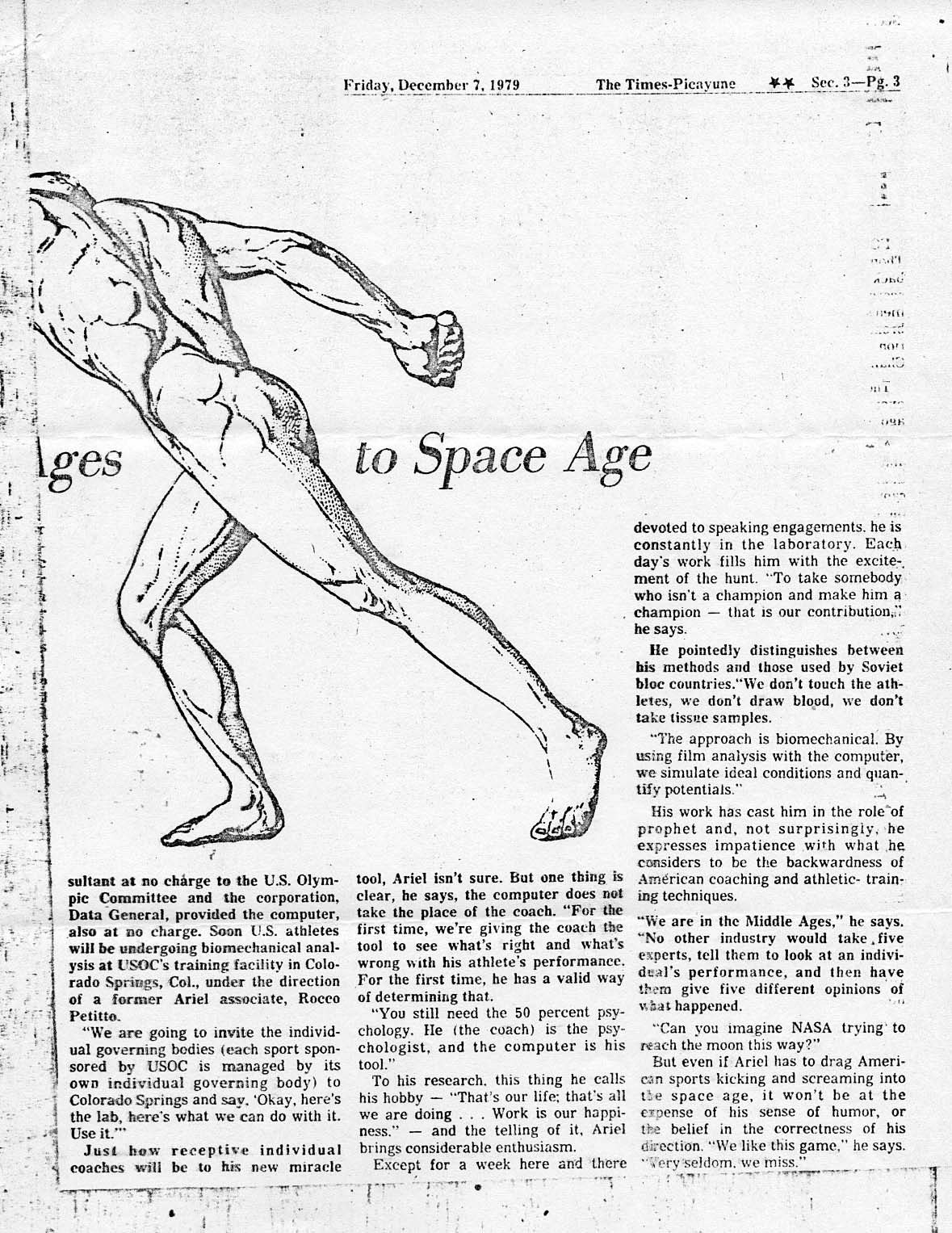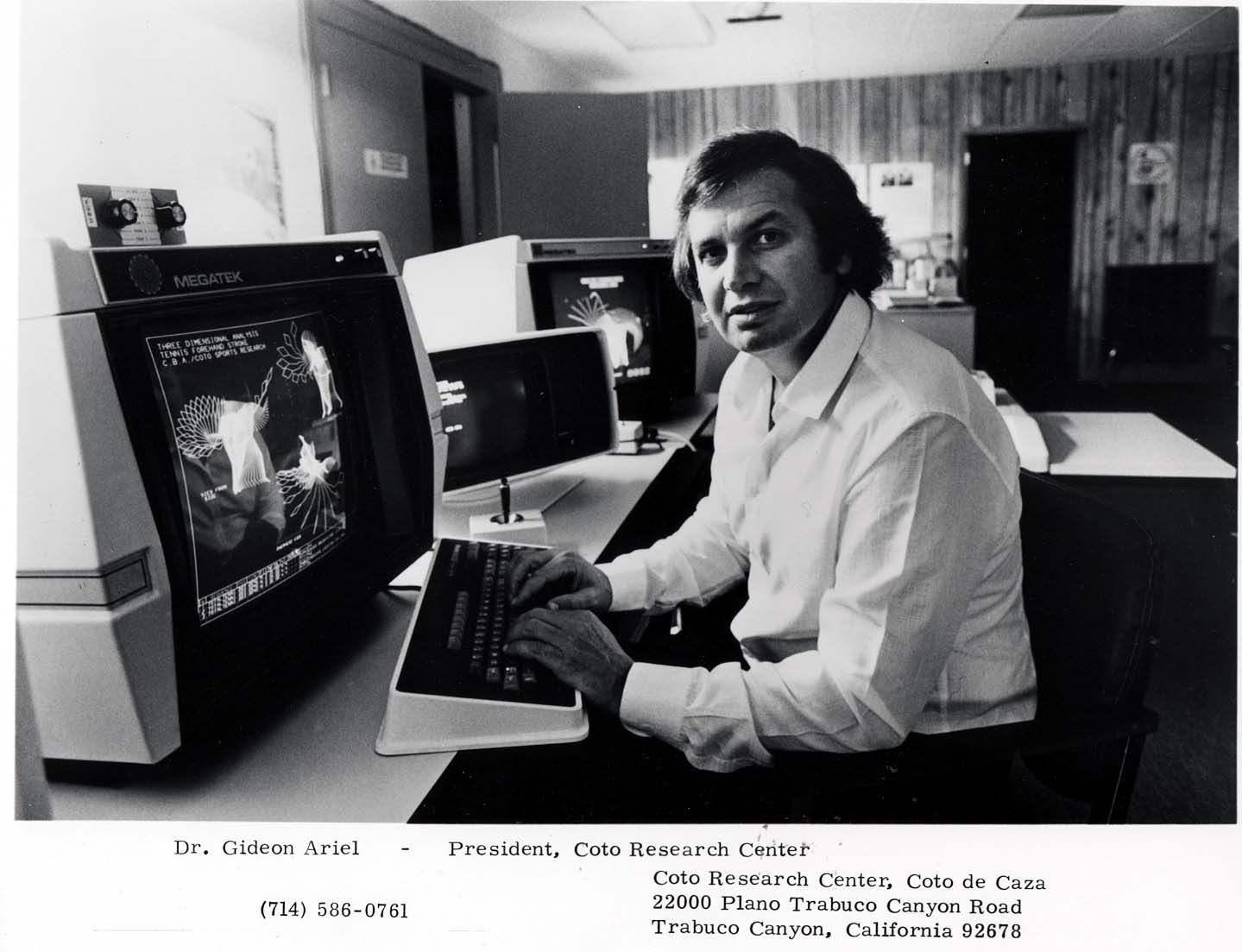Bringing Athletics from Middle Ages
As Director of Biomechanics for the U.S. Olympic Committee, he'll help prepare American athletes
By Robert Steckel in The Times-Picayune on Friday, December 7, 1979
Dr. Gideon Ariel, Director of Biomechanics for the U.S. Olympic Committee, is revolutionizing sports through the application of high-speed photography and computer analysis. His work at his Amherst, Massachusetts laboratory has made three-dimensional analysis of body movement a relatively easy process. This allows athletes to understand the relationship between their body movements and speed, enabling them to improve their performance. Ariel, a former Olympic athlete himself, has used his expertise to benefit prominent athletes and sporting goods manufacturers. He has also offered his services as a consultant to the U.S. Olympic Committee and the corporation, Data General, at no charge. Ariel's work is not meant to replace coaches but to provide them with a tool to better understand and improve their athletes' performance.
Tip: use the left and right arrow keys
Biomechanics
By ROBERT STECKEL
"You have a football team here?" Dr. Gideon Ariel asks.
"Yes, the Saints."
"Ah. yes," he nods with a knowing smile. They need help. I can help then."
Gideon Ariel can help. He is already helping.
As Director of Biomechanics for the U.S. Olympic Committee, he'll help prepare American athletes for their trip'to�Moscow in 1980 and analyze performances there.
Ariel doesn't look like a revolutionary, but in a sense that is what he is. At his Amherst. Mass., laboratory, he has wedded high speed photography with the computer and applied the scientific method to sports.
What that marriage has done is to make three-dimensional analysis of body movement a relatively easy process. By showing the athlete the relationship between the attitude of his body parts and the speed with which he moves them. Ariel can show him how to change his technique and improve his performance.
"It's basic high school physics," Ariel says. "It had been done before, but the only thing was, with so many calculations, it took months. Now, using computers, it takes days."
Were Ariel merely a theoretician, his statements might not carry the; authority they do Ilut he speak' as a former Olympic athlete himself, and a wise teacher with absolute command
o Sports
_N/f dzl~ e i r i "- a
of his subject. matter.
Ariel is 16 years removed from his homeland. but he still speaks with a heavy Hebrew accent. Raised on a kibbutz in the town of Natanva. 20 miles north of Tel Aviv, he began putting the shot and throwing the discus when he was 17, and was a member of Israel's 1960 and 19;;4 Olympic teams.
In 1963 he left Israel to attend the University of Wyoming on a track scholarship. In 1966 he applied to the University of Massachusetts' newly created School of Exercise Science and, nine months after enrolling, had his master's degree, and soon afterward, his Ph.D.
Much of his time in gradu_ite school was spent tracing body movements on paper - drudgery, at best. The head of the computer science department suggested applying a computer to the mechanics, and shortly thereafter a career was bunched.
of hours programming in computer language the body movements of individual athletes. Discus throwers Mac Wilkins and Al Oerter, snot putter Terry Albritton. tennis player 'artina Navratilova and frisbee pro Doug Kir kling are some of the prominent athletes who have benefitted from his expertise.
He has served as a consultant to sporting good manufacturers, and recently he became part of a real estate venture in Orange County. Calif., that will use his planned Sports Research Center as a magnet to attract fitness-minded corporations and individuals to settle there.
A vice-president of the Amherstbased Computerized Biomechanical Analysis, Inc., Ariel was in New Orleans Wednesday as a guest speaker for a convention sponsored by the same Massachusetts computer corporation that is participating in the Olympics project.
Ariel offered his services as a con
-=-1 3- anont thousands
Friday, December 7. 1979 _ The Times-Picayune
Sec.:-Pa. 3
H
P_
sultant at no charge to the U.S. Olympic Committee and the corporation, Data General, provided the computer, also at no charge. Soon U.S. athletes will be undergoing biomechanical analysis at t'SOC's training facility in Colorado Springs, Col., under the direction of a former Ariel associate, Rocco Petitto_
"We are going to invite the individual governing bodies (each sport sponsored by USOC is managed by its own individual governing bod)) to Colorado Springs and say. 'Okay, here's the lab, here's what we can do with it.
Use it.
Just how receptive individual coaches will be to his new miracle
tool, Ariel isn't sure. But one thing is clear, he says, the computer does not take the place of the coach. "For the first time, we're giving the coach the tool to see what's right and what's wrong v ith his athlete's performance. For the first time, he has a valid way of determining that.
"You still reed the 50 percent psychology. Ile (the coach) is the psychologist, and the computer is his tool."
To his research. this thing he calls his hobby - "That's our life: that's all we are doing ... Work is our happiness." - and the telling of it, Ariel brings considerable enthusiasm.
Except for a week here and there
devoted to speaking engagements. he is constantly in the laboratory. Each day's work fills him with the excite-, ment of the hunt. "To take somebody who isn't a champion and make him a champion - that is our contribution,." he says.
Ile pointedly distinguishes between his methods and those used b_v Soviet bloc countries." We don't touch the athletes, we don't draw blood, use don't take tissue samples.
"The approach is biomechanical. By using film analysis with the computer, we simulate ideal conditions and quanti#v potentials."
His work has cast him in the role -of prophet and, not surprisingiv, he expresses impatience with what he considers to be the backwardness of American coaching and athletic- training techniques.
"We are in the Middle Ages," he says. "No other industry would take. five experts, tell them to look at an individa,31's performance, and then have ti' m give five different opinions of s bat happened.
"Can you imagine NASA trying' to reach the moon this way?"
But even if Ariel has to drag Americ:,n sports kicking and screaming into t`e space age, it won't he at the c-ense of his sense of humor, or 0--2 belief in the correctness of his di: ection. "We like this game." he says.
-rv seldom. v; e miss."
Dr. Gideon Ariel (714) 586-0761
President, Coto Research Center
Coto Research Center, Coto de Caza 22000 Plano Trabuco Canyon Road Trabuco Canyon, California 92678



